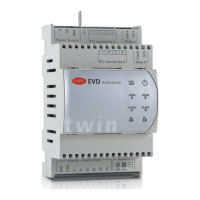ENG
“EVD Evolution TWIN” +0300006EN - rel. 2.6 - 31.01.2019
35
Note:
• the LOP threshold must be lower then the rated evaporation temperature
of the unit, otherwise it would be activated unnecessarily, and greater than
the calibration of the low pressure switch, otherwise it would be useless. As
an initial approximation it can be set to a value exactly half-way between
the two limits indicated;
• the protector has no purpose in multiplexed systems (showcases) where
the evaporation is kept constant and the status of the individual electronic
valve does not aect the pressure value;
• the LOP alarm can be used as an alarm to highlight refrigerant leaks by
the circuit. A refrigerant leak in fact causes an abnormal lowering of the
evaporation temperature that is proportional, in terms of speed and extent,
to the amount of refrigerant dispersed.
t
t
t
OFF
ON
A
OFF
ON
LOP
LOP_TH
T_EVAP
D
B
Fig. 7.b
Key:
T_EVAP Evaporation temperature D Alarm delay
LOP_TH Low evaporation temperature
protection threshold
ALARM Alarm
LOP LOP protection t Time
B Automatic alarm reset
MOP (high evaporation pressure)
MOP= Maximum Operating Pressure.
The MOP protection threshold is applied as a saturated evaporation
temperature value so that it can be easily compared against the technical
specications supplied by the manufacturers of the compressors. The
protector is activated so as to prevent too high evaporation temperatures
from causing an excessive workload for the compressor, with consequent
overheating of the motor and possible activation of the thermal protector.
The protector is very useful in units with compressor on board if starting with
a high refrigerant charge or when there are sudden variations in the load.
The protector is also useful in multiplexed systems (showcases), as allows
all the utilities to be enabled at the same time without causing problems of
high pressure for the compressors. To reduce the evaporation temperature,
the output of the refrigeration unit needs to be decreased. This can be done
by controlled closing of the electronic valve, implying superheat is no longer
controlled, and an increase in the superheat temperature. The protector
will thus have a moderate reaction that tends to limit the increase in the
evaporation temperature, keeping it below the activation threshold while
trying to stop the superheat from increasing as much as possible. Normal
operating conditions will not resume based on the activation of the protector,
but rather on the reduction in the refrigerant charge that caused the increase
in temperature. The system will therefore remain in the best operating
conditions (a little below the threshold) until the load conditions change.
Parameter/description Def. Min. Max. UOM
CONTROL
MOP protection: threshold 50 LOP protection:
threshold
200
(392)
°C (°F)
MOP protection: integral time 20 0 800 s
ALARM CONFIGURATION
High evaporation temperature
alarm delay (MOP)
(0= alarm disabled)
600 0 18000 s
Tab. 7.d
The integral time is set automatically based on the type of main control.
When the evaporation temperature rises above the MOP threshold, the system
enters MOP status, superheat control is interrupted to allow the pressure to
be controlled, and the valve closes slowly, trying to limit the evaporation
temperature. As the action is integral, it depends directly on the dierence
between the evaporation temperature and the activation threshold. The more
the evaporation temperature increases with reference to the MOP threshold,
the more intensely the valve will close. The integral time indicates the intensity
of the action: the lower the value, the more intense the action.
t
t
t
t
OFF
ON
ALARM
OFF
ON
PID
OFF
ON
MOP
MOP_TH - 1
MOP_TH
T_EVAP
D
Fig. 7.c
Key:
T_EVAP Evaporation temperature MOP_TH MOP threshold
PID PID superheat control ALARM Alarm
MOP MOP protection t Time
D Alarm delay
Important: the MOP threshold must be greater than the rated
evaporation temperature of the unit, otherwise it would be activated
unnecessarily. The MOP threshold is often supplied by the manufacturer of
the compressor. It is usually between 10°C and 15 °C.
If the closing of the valve also causes an excessive increase in the suction
temperature (S2) above the set threshold – only set via supervisor (PlantVisor,
pCO, VPM), not on the display - the valve will be stopped to prevent
overheating the compressor windings, awaiting a reduction in the refrigerant
charge. If the MOP protection function is disabled by setting the integral time
to zero, the maximum suction temperature control is also deactivated.
Parameter/description Def. Min. Max. UOM
CONTROL
MOP protection: suction temperature
threshold
30 -60 (-72) 200 (392) °C(°F)
Tab. 7.e
At the end of the MOP protection function, superheat control restarts in a
controlled manner to prevent the evaporation temperature from exceeding
the threshold again..

